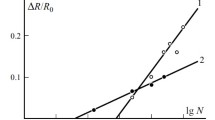Abstract
Using a new parallel beam apparatus, the dynamic mechanical properties of poly-(methyl methacrylate) were determined over a wide range of molecular weights (1500< <\(\overline M _n\)<600 000). Results showed that the modulus (25 °C) was only slightly dependent on chain length, and equalled 2.3×109 Pa for the highest molecular weight scanned. Simultaneous acquisition ofα- andβ-relaxations indicated a decrease inT α in accordance with Gibbs' relation, whileT β was invariant. BothT ∞α =111° andT ∞β =40° corroborated previous results from several sources, including dynamic mechanical measurements. Such modulus and glass transition data are essential to the calculation of fracture toughness and to the assessment of radiation damage of acrylic, respectively.
Résumé
En se servant d'un nouvel appareil à rayons parallèles, on a déterminé les propriétés mécaniques dynamiques du poly(méthyl-méthacrylate) dans un large intervalle de poids moléculaires (1500<\(\overline M _n\)<600 000). Les résultats on montré que le module (25°) ne dépend que peu de la longueur de la chaîne et est égal à 2.3×109 Pa pour le plus haut poids moléculaire étudié. L'acquisition simultanée des relaxationsα etβ a indiqué, en accord avec la relation de Gibbs, une diminution deT α tandis queT β s'avere invariable. Les valeursT ∞α =111°et}T ∞β =40° ont corroboré toutes deux des résultats antérieurs de diverses sources, y compris des mesures mécanique dynamiques. Un tel module ainsi que les données de la transition vitreuse sont essentiels pour calculer la résistance à la rupture, et pour déterminer les dommages par irradiation des matières acryliques.
Zusammenfassung
Unter Anwendung eines neuen Parallelstrahlgerätes wurden die dynamischen mechanischen Eigenschaften von Poly(methylmethacrylat) in einem weiten Molmassenbereich (1500<\(\overline M _n\)<600 000) bestimmt. Die Ergebnisse zeigten, daß der Modul (25°) nur wenig von der Kettenlänge abhängig und für die höchste erfaßte Molmasse gleich 2.3× ×109 Pa war. Die gleichwertige Erfassung derα- undβ-Relaxationen zeigte in Übereinstimmung mit der Gibbs-schen Abhängigkeit eine Abnahme vonT α währendT β unverändert blieb. SowohlT ∞α =111° als auchT ∞β =40° bestätigten frühere Ergebnisse verschiedenen Ursprungs, dynamische mechanische Messungen mit inbegriffen. Solch ein Modul und Glas-Übergangsdaten sind zur Berechnung der Bruchfestigkeit bzw. zur Bestimmung der Bestrahlungsschäden in Acrylaten unerläßlich.
Резюме
Используя новую аппа ратуру с параллельны м балансиром, были опре делены динамические механи ческие свойства полиметилметакрила та в широкой области м олекулярных весов (1500 <\(\overline M _n\) < 600 000). Результ аты показали, что моду ль (25°) только слегка зависил от длины цепи и был равным 2.3х109 Па для полимера с наибольши м молекулярным весом. Одновременное приобретение αа- и β-ре лаксаций показало уменьшениеT α в соответствии с соо тношением Гиббса, в то время какT β не изменялось. Об аT ∞α =111° иT ∞β =40° подтверждены пр едыдущими результат ами из нескольких источник ов, включая динамические механи ческие измерения. Так ие модули и данные стеклообразн ого превращения ценны при вычислении разрыва вязкости и дл я оценки радиоактивного повр еждения акрилоида.
Similar content being viewed by others
References
R. P. Kusy andD. T. Turner, Polymer, 17 (1976) 161.
R. P. Kusy andM. J. Katz, Polymer, 19 (1978) 1345.
R. P. Kusy andD. T. Turner, Polymer, 18 (1977) 391.
R. P. Kusy, M. J. Katz andD. T. Turner, Thermochim. Acta, 26 (1978) 415.
R. P. Kusy andD. T. Turner, J. Polymer Sci., 12 (1974) 2137.
R. P. Kusy, J. Polymer Sci., 14 (1976) 1527.
R. P.Kusy and A. R.Greenberg, Thermochim. Acta, (in press).
G. P. Koo, Plastics Eng., 30 (1974) 33.
L. E. Nielsen, Mechanical Properties of Polymers, Reinhold, New York, 1967, p. 7 and Ch. 7.
A. E. Woodward, J. Polymer Sci., 14 (1966) 89.
J. Heijboer, from J. A. Prins, Physics of Non-Crystalline Solids, North Holland, Amsterdam, 1965, p. 231.
S. Havriliak, Jr., Polymer, 9 (1968) 289.
Y. Ishida, Kolloid-Z., 174 (1961) 124.
S. L.Kim, M.Skibo, J. A.Manson and R. W.Hertzberg, Poly. Eng. Sci., 17 (1977) No. 3.
S. G. Turley andH. Keskkula, J. Polymer Sci., 14 (1966) 69.
A. E. Woodward andJ. A. Sauer, Fortsch. Hochpolym.-Forsch., 1 (1958) 114.
M. Dole, The Radiation Chemistry of Macromolecules, Academic Press, New York, 1973, Vol. 2, Ch. 6.
S. R. Sandler andW. Karo, Polymer Synthesis, Vol. 1, Academic Press, New York, 1974, p. 297.
Use of Acrylic Monomers in the Preparation of Low Number Average Molecular Weight Polymers, Rohm and Haas Technical Report TMM-23, March 1965.
F. A. Bovey, The Effects of Ionizing Radiation on Natural and Synthetic High Polymers, Interscience, New York, 1958.
E. V. Thompson, J. Polymer Sci., 4 (1966) 199.
R. P.Kusy, (unpublished work).
R. L.Hassel and P. S.Gill, paper #20 (Shear Measurements with the Dynamic Mechanical Analyzer) presented at the Eighth North American Thermal Analysis Society Conference, Atlanta, Ga., Oct. 1978.
K. E. Deutsch, A. W. Hoff, andW. Reddish, J. Polymer Sci., 13 (1954) 565.
J. Heijboer, Kolloid-Z., 148 (1956) 36.
R. D. Andrews, J. Polymer Sci., 14 (1966) 261.
H. Niklas, Kunststoffe, 53 (1963) 158.
H. Niklas andH. K. von Schmeling, Kunststoffe, 53 (1963) 839, 886.
L. E. Nielsen, Soc. Plastics Eng. J., 16 (1960) 525.
Dupont Instruments 980 DMA Operation Manual, Sections 3–9/3–10, Figure 3–11.
R. P. Kusy, J. Biomed. Mat. Res., 12 (1978) 271.
R. B. Beevers andE. F. T. White, Trans. Faraday Soc., 56 (1960) 744.
J. H. Gibbs, J. Chem. Phys., 25 (1956) 185.
Author information
Authors and Affiliations
Additional information
This investigation was supported by NIH Research Grant No. DE 02668, RCDA number DE 00052 (R.P.K.), and RFA number DE 05132 (A.R.G.).
Rights and permissions
About this article
Cite this article
Kusy, R.P., Greenberg, A.R. Influence of molecular weight on the dynamic mechanical properties of poly(methyl methacrylate). Journal of Thermal Analysis 18, 117–126 (1980). https://doi.org/10.1007/BF01909459
Received:
Issue Date:
DOI: https://doi.org/10.1007/BF01909459




